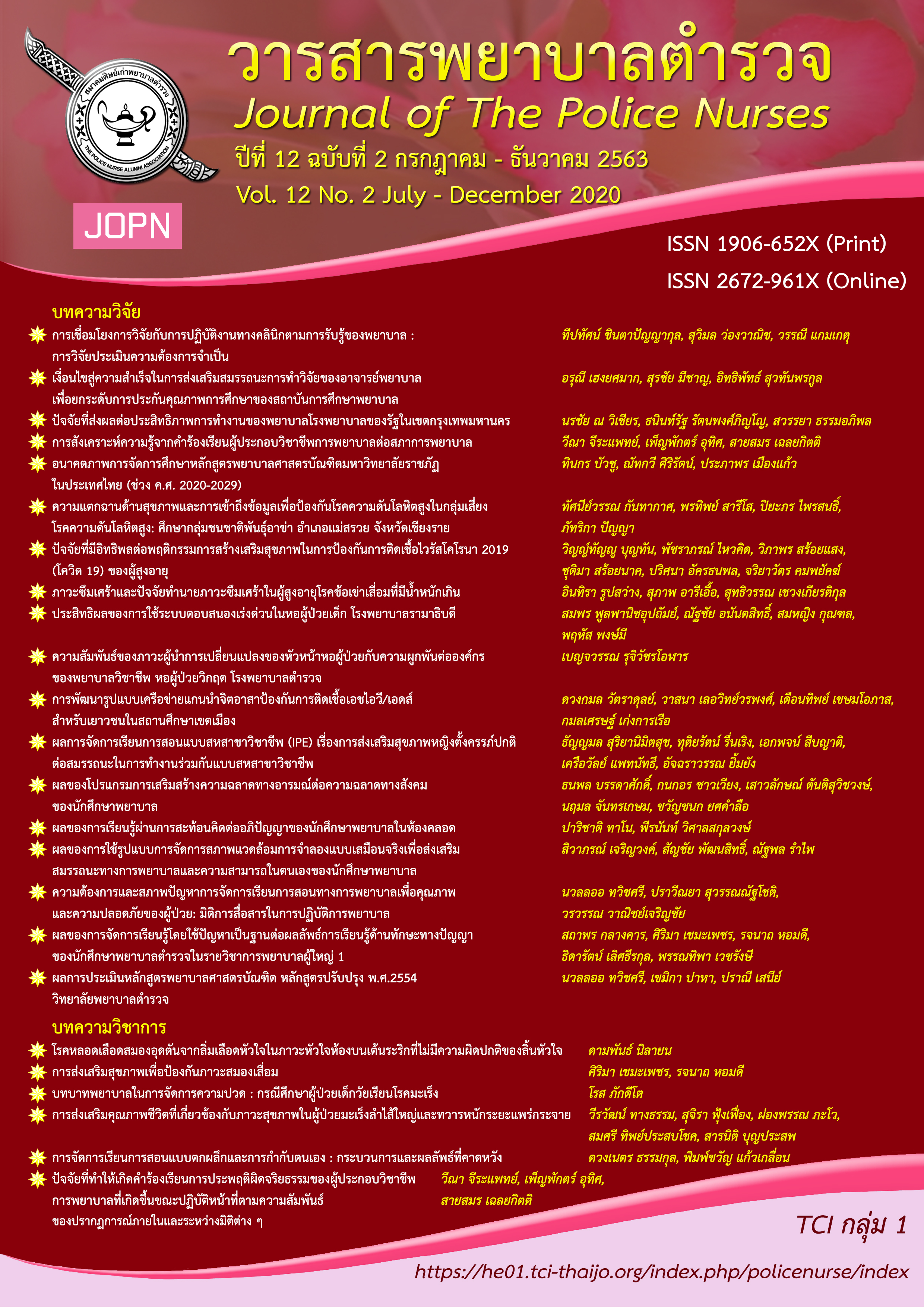ภาวะซึมเศร้าและปัจจัยทำนายภาวะซึมเศร้าในผู้สูงอายุโรคข้อเข่าเสื่อมที่มีน้ำหนักเกิน
คำสำคัญ:
ภาวะซึมเศร้า, ปัจจัยทำนาย, ผู้สูงอายุโรคข้อเข่าเสื่อมที่มีน้ำหนักเกินบทคัดย่อ
การศึกษาเชิงบรรยายภาคตัดขวางในครั้งนี้มีวัตถุประสงค์เพื่อศึกษาความชุกภาวะซึมเศร้า และปัจจัยทำนายภาวะซึมเศร้าในผู้สูงอายุโรคข้อเข่าเสื่อมที่มีน้ำหนักเกิน กลุ่มตัวอย่าง คือ ผู้สูงอายุที่อาศัยอยู่ในชุมชน 119 คน ที่ผ่านเกณฑ์คัดเข้า คือ อายุเท่ากับหรือมากกว่า 60 ปี ได้รับการวินิจฉัยโรคข้อเข่าเสื่อมโดยเกณฑ์การวินิจฉัยโรคข้อเข่าเสื่อมของวิทยาลัยโรคข้อแห่งสหรัฐอเมริกา ดัชนีมวลกาย 23.00-29.99 กิโลกรัม/ตารางเมตร และสามารถปฏิบัติกิจวัตรประจำวันได้ด้วยตนเอง เก็บรวบรวมข้อมูลโดยวิธีการสัมภาษณ์โดยใช้เครื่องมือเป็นแบบบันทึกภาวะสุขภาพ แบบประเมินความเหนื่อยล้าแบบหลายมิติ แบบวัดความเศร้าในผู้สูงอายุไทย-15 และแบบประเมินความรุนแรงของโรคข้อเข่าเสื่อม วิเคราะห์ข้อมูลโดยใช้สถิติบรรยายและการวิเคราะห์ถดถอยโลจิสติก
ผลการศึกษาพบว่า 1) ร้อยละ 47.89 ของกลุ่มตัวอย่างมีภาวะซึมเศร้า 2) อายุและความเหนื่อยล้าเป็นตัวแปรทำนายภาวะซึมเศร้าอย่างมีนัยสำคัญทางสถิติที่ระดับ .05 (Odds ratio=1.07, 95%CI=1.009 - 1.132, p=.024; Odds ratio=1.08, 95%CI=1.026 - 1.142, p=.004 ตามลำดับ) แม้ว่าตัวแปรดังกล่าวจะทำนายภาวะซึมเศร้าได้เพียงเล็กน้อย แต่สามารถเป็นข้อมูลพื้นฐานสำคัญสำหรับทีมสุขภาพให้ตระหนักถึงผลกระทบของโรคข้อเข่าเสื่อมทั้งด้านร่างกายและจิตใจ รวมทั้งความเหนื่อยล้าซึ่งเป็นอาการร่วมของโรคข้อเข่าเสื่อม
Downloads
เอกสารอ้างอิง
Altman, R., Asch, E., Bloch, D., Bole, G., Borenstein, D., Brandt, K., . . . Hochberg, M. (1986). Development of criteria for the classification and reporting of osteoarthritis. Classification of osteoarthritis of the knee. Diagnostic and Therapeutic Criteria Committee of the American Rheumatism Association. Arthritis and Rheumatism, 29 (8), 1039 - 1049.
Aekplakorn, W., & Mo-Suwan, L. (2009). Prevalence of obesity in Thailand. Obesity Reviews, 10(6), 589-592.
Ahn, H., Weaver, M., Lyon, D., Choi, E., & Fillingim, R. B. (2017). Depression and pain in Asian and White Americans with knee osteoarthritis. Journal of Pain, 18(10), 1229-1236.
Alkan, B. M., Fidan, F., Tosun, A., & Ardicoglu, O. (2014). Quality of life and self-reported disability in patients with knee osteoarthritis. Modern Rheumatology, 24(1), 166-171.
American Academy of Orthopedic Surgeons 2013. (2013). Treatment of osteoarthritis of the knee, evidence-based guideline (2nd ed.). Rosemont, IL: The American Academy of Orthopaedic Surgeons.
Aree-Ue, S., Kongsombun, U., Roopsawang, I., & Youngcharoen, P. (2019). Path model of factors influencing health-related quality of life among older people with knee osteoarthritis. Nursing & Health Sciences, 21(3), 45-351.
Belza, B. L., Henke, C. J., Yelin, E. H., Epstein, W. V., & Gilliss, C. L. (1993). Correlates of fatigue in older adults with rheumatoid arthritis. Nursing Research, 42(2), 93-99.
Belza, B., Miyawaki, C. E., Liu, M., Aree-Ue, S. Fessel, M., Minott, K. R., & Zhang, X. (2018). A systematic review of studies using the multidimensional assessment of fatigue scale. Journal of Nursing Measurement, 26(1), 36-75.
Berenbaum, F. (2011). Diabetes-induced osteoarthritis: From a new paradigm to a new phenotype. Annals of the Rheumatic Diseases, 70(8), 1354-1356.
Campbell, L. C., Clauw, D. J., & Keefe, F. J. (2003). Persistent pain and depression: A biopsychosocial perspective. Biological Psychiatry, 54(3), 399-409.
Chung, H. Y., Kim, D. H., Lee, E. K., Chung, K. W, Chung, S., Lee, B., . . . Yu, B. P. (2019). Redefining chronic inflammation in aging and age-related diseases: Proposal of the senoinflammation concept. Aging and Disease, 10(2), 367-382.
Cross, M., Smith, E., Hoy, D., Nolte, S., Ackerman, I., Fransen, M., . . . March, L. (2014). The global burden of hip and knee osteoarthritis: Estimates from the global burden of disease 2010 study. Annals of the Rheumatic Diseases, 73(7), 1323-1330.
Davis, J. C., Falck, R. S., Best, J. R., Chan, P., Doherty, S., & Liu-Ambrose, T. (2019). Examining the inter-relations of depression, physical function, and cognition with subjective sleep parameters among stroke survivors: A cross-sectional analysis. Journal of Stroke and Cerebrovascular Diseases, 28(8), 2115-2123.
Duangthipsirikul, S., Sirisamut, T., Tantipisitkun, K., Ingsasawang, S. L., & Thirawattananon, Y. (2013). Report of the Thai elderly health survey 2013 under the elderly and people health promotion program disabled. Bangkok: Watcharin Printing Center.
Fatemi, A., Iraj, B., Barzanian, J., Maracy, M., & Smiley, A. (2015). Musculoskeletal manifestations in diabetic versus prediabetic patients. International Journal of Rheumatology, 18(7), 791-799.
Ferreira, A. H., Godoy, P. B. G., Oliveira, N. R. C. D., Diniz, R. A. S., Diniz, R. E. A. S., Padovani, R. D. C., & Silva, R. C. B. D. (2015). Investigation of depression, anxiety and quality of life in patients with knee osteoarthritis: A comparative study. Revista Brasileira de Reumatologia, 55(5), 434-438.
Fowler-Brown, A., Kim, D. H., Shi, L., Marcantonio, E., Wee, C. C., Shmerling, R. H., & Leveille, S. (2015). The mediating effect of leptin on the relationship between body weight and knee osteoarthritis in older adults. Arthritis & Rheumatology, 67(1), 169-175.
Garip, Y., Güler, T., & Tuncer, Ö. B. (2016). Fatigue among elderly patients with knee osteoarthritis and its association with functional status, depression and quality of life. Ankara Medical Journal, 16(1), 20-26.
Haq, S. A., & Davatchi, F. (2011). Osteoarthritis of the knees in the COPCORD world. International Journal of Rheumatic Diseases, 14(2), 122-129.
Jenkins, J. B., & McCoy, T. P. (2015). Symptom clusters, functional status, and quality of life in older adults with osteoarthritis. Orthopaedic Nursing, 34(1), 36-42; quiz 43-34.
Karnjanavorawong, P. (1997). Quality of life in the elderly with osteoarthritis of the knee (Thesis in Master of Nursing Science, Adult Nursing). Faculty of Graduate Studies, Mahidol University,
King, L. K., March, L., & Anandacoomarasamy, A. (2013). Obesity & osteoarthritis. The Indian Journal of Medical Research, 138, 185-193.
King, K. B., & Rosenthal, A. K. (2015). The adverse effects of diabetes on osteoarthritis: Update on clinical evidence and molecular mechanisms. Osteoarthritis and Cartilage, 23(6), 841-850.
Kongsombun, U, Aree-Ue, S., & Youngcharoen, P. (2019). Depression, fatigue, and physical performance among older adults with knee osteoarthritis: A correlational study. Ramathibodi Nursing Journal, 25(3), 310-325.
Kuptniratsaikul, V., Tosayanonda, O., Nilganuwong, S., & Thamalikitkul, V. (2002). The epidemiology of osteoarthritis of the knee in elderly patients living an urban area of Bangkok. Journal-Medical Association of Thailand, 85(2), 154-161.
Pai, L. W., Hung, C. T., Li, S. F., Chen, L. L., Chung, Y., & Liu, H. L. (2015). Musculoskeletal pain in people with and without type 2 diabetes in Taiwan: A population-based, retrospective cohort study. BMC Musculoskeletal Disorders, 16(1), 364. doi:10.1186/s12891-015-0819-4
Parmelee, P. A., Tighe, C. A., & Dautovich, N. D. (2015). Sleep disturbance in osteoarthritis: Linkages with pain, disability, and depressive symptoms. Arthritis Care & Research, 67(3), 358-365.
Rathbun, A. M., Yau, M. S., Shardell, M., Stuart, E. A., & Hochberg, M. C. (2017). Depressive symptoms and structural disease progression in knee osteoarthritis: Data from the Osteoarthritis Initiative. Clinical Rheumatology, 36(1), 155-163.
Schepens, S. L., Kratz, A. L., & Murphy, S. L. (2012). Fatigability in osteoarthritis: effects of an activity bout on subsequent symptoms and activity. The Journals of Gerontology: Series A, 67(10), 1114–1120.
Schett, G., Kleyer, A., Perricone, C., Sahinbegovic, E., Iagnocco, A., Zwerina, J., . . . Kiechl, S. (2013). Diabetes is an independent predictor for severe osteoarthritis: results from a longitudinal cohort study. Diabetes Care, 36(2), 403-409.
Smith, D. M., & Parmelee, P. A. (2016). Within-day variability of fatigue and pain among African Americans and non-Hispanic whites with osteoarthritis of the knee. Arthritis and Care Research, 68(1), 115-122.
Stebbings, S., Herbison, P., Doyle, T. C., Treharne, G. J., & Highton, J. (2010). A comparison of fatigue correlates in rheumatoid arthritis and osteoarthritis: Disparity in associations with disability, anxiety and sleep disturbance. Rheumatology, 49(2), 361-367.
Sundberg, C. W., Kuplic, A., Hassanlouei, H., & Hunter, S. K. (2018). Mechanisms for the age-related increase in fatigability of the knee extensors in old and very old adults. Journal of Applied Physiology, 125(1), 146-158.
Tanavalee, A. (2014). Knee Osteoarthritis. In A. Tanavalee, S. Ngarmukos, Y. Wangroongsub (Eds.), Textbook of core orthopedic knowledge for medical doctor (pp. 56-65). Bangkok: Department of Orthopaedics Faculty of Medicine Chulalongkorn University Limited.
Tangtrakulwanich, B., Chongsuvivatwong, V., & Geater, A. F. (2007). Habitual floor activities increase risk of knee osteoarthritis. Clinical Orthopaedics and Related Research, 454, 147-154.
Trongsakul, S., Lambert, R., Clark, A., Wongpakaran, N., & Cross, J. (2015). Development of the Thai version of Mini-Cog, a brief cognitive screening test. Geriatrics & Gerontological International, 15(5), 594-600.
Wongpakaran, N., Wongpakaran, T., & Van Reekum, R. (2013). The use of GDS-15 in detecting MDD: A comparison between residents in a Thai long-term care home and geriatric outpatients. Journal of clinical medicine research, 5(2), 101-111.
Wood, S. K., Wood, C. S., Lombard, C. M., Lee, C. S., Zhang, X. Y., Finnell, J. E., & Valentino, R. J. (2015). Inflammatory factors mediate vulnerability to a social stress-induced depressive-like phenotype in passive coping rats. Biological psychiatry, 78(1), 38–48.
Zheng, H., & Chen, C. (2015). Body mass index and risk of knee osteoarthritis: systematic review and meta-analysis of prospective studies. BMJ Open, 5(12), e007568. doi:10.1136/bmjopen-2014-007568
ดาวน์โหลด
เผยแพร่แล้ว
รูปแบบการอ้างอิง
ฉบับ
ประเภทบทความ
สัญญาอนุญาต
ผลงานที่ได้ตีพิมพ์แล้วจะเป็นลิขสิทธิ์ของวารสารพยาบาลตำรวจ















